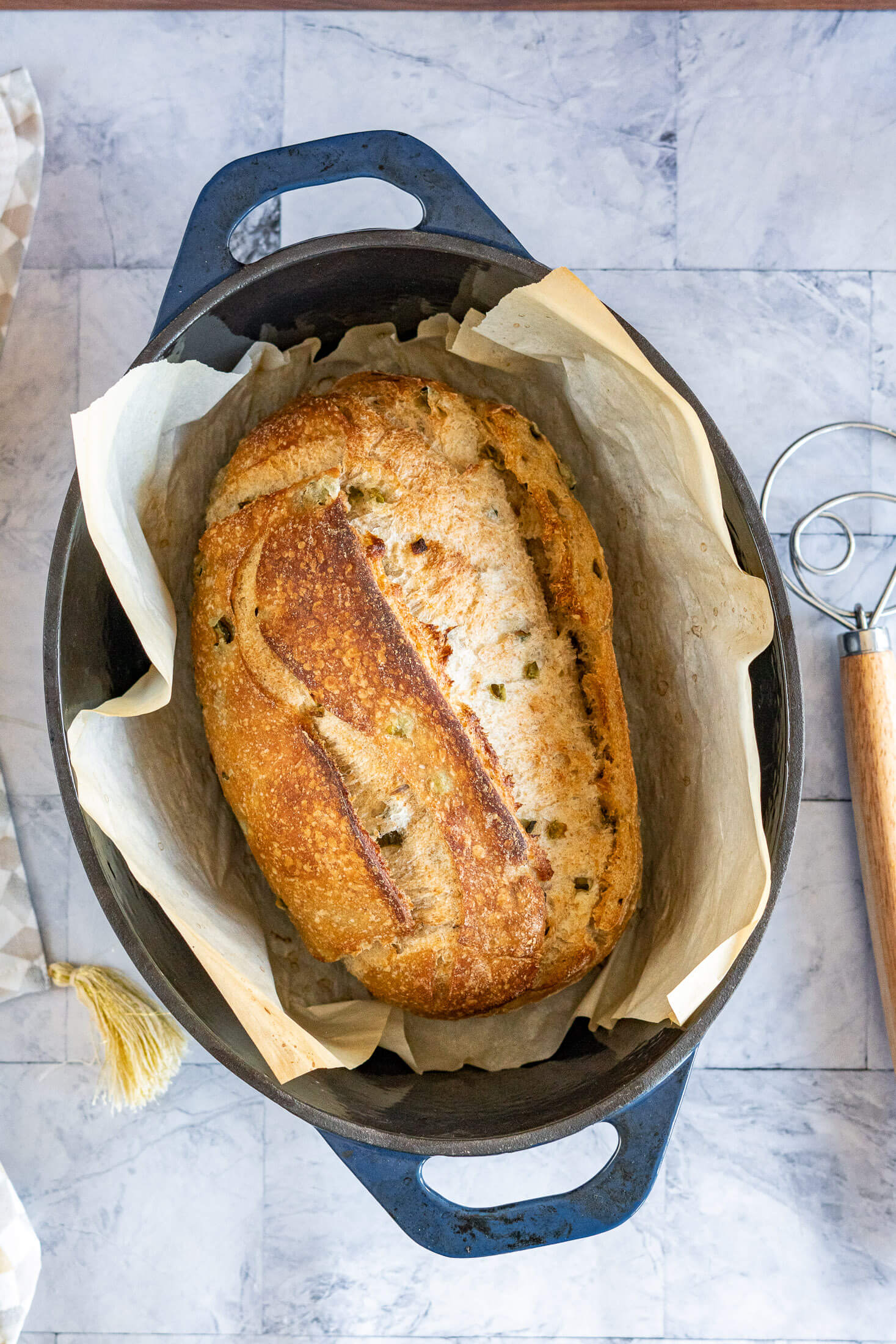Dill Pickle Sourdough Bread
4.8
(8)
Your folders
Your folders
Prep Time: 1200 minutes
Cook Time: 45 minutes
Total: 1245 minutes
Servings: 10

Ingredients
Export 6 ingredients for grocery delivery
Instructions
Step 1
In a large bowl, combine 180g warm water with 150g pickle juice and whisk in 100g of active sourdough starter until mostly combined.
Step 2
Add 400g bread flour and 100g dark rye flour and mix until a shaggy dough forms. Knead the dough with your hands until all the shaggy bits are incorporated. Sprinkle 5 g fine sea salt on top of the dough.
Step 3
Cover the bowl and set aside for 45 - 60 minutes.
Step 4
Uncover the bowl and using damp hands, grab the dough and gently pull it until the flap is long enough to fold over itself, then fold the flap, rotate the bowl 90 degrees, and repeat 4 times.
Step 5
Recover the bowl, and set it aside for 30 minutes. Meanwhile, dice 150g of dill pickles and wrap them in paper towel to absorb some of the moisture.
Step 6
Before the 2nd set of stretch and folds, add 150g of diced pickles and stretch and fold to incorporate the inclusions. Allow to rest for another 30 minutes and perform 2 more sets of stretch and folds, for a total of 4 sets. This helps to completely incorporate the pickles. If you find the pickles are too wet and pulling apart the dough after the final stretch and fold, generously flour the working surface and the dough and gently knead the dough until it comes together cohesively.
Step 7
After the 4th and final stretch and fold, cover the bowl and set aside for 2 hours to bulk ferment. It is important to keep the dough bowl somewhere warm to encourage the microbes to work quickly!
Step 8
Lightly flour the work surface and turn the dill pickle dough out onto the floured surface. Try to get the smooth top part face down so that the sticky underside is on top facing you, this will make shaping the dough easier.
Step 9
Fold the sides into the middle. Then starting from the bottom, tightly roll the dough into a batard. Stop there if making a batard, or tuck the long ends underneath to create a boule.
Step 10
Allow the dough to rest covered for 20 minutes.
Step 11
Place your hands underneath the dough and using your pinkies, apply pressure to the dough and drag it along the work surface to increase surface tension in the dough. Avoid overtightening the dough because it may tear with the inclusions.
Step 12
Dust the top of your boule or batard with rice flour, then use a bench scraper to pick up the dough, flip it, and place it upside down, or seam side up, into a banneton to prove for 2 hours.
Step 13
Cover the banneton with a reusable plastic bag and place it in the fridge. During the proving period, the dough will rise in the banneton, but due to the cool temperatures in the fridge, it won't be a marked difference.
Step 14
Place your dutch oven, cloche, or desired baking dish in the oven and preheat to 450f.
Step 15
Once the oven is preheated, remove the dough from the fridge and invert the banneton onto a sheet of parchment paper.
Step 16
Use a lame, sharp knife, or clean razor blade to score the dough, I usually like to make one deep curved slash when adding inclusions, but you can get as fancy as you like!
Step 17
Carefully remove the dutch oven from the oven, and using the parchment paper as a sling, transfer the sourdough loaf from the counter into the dutch oven.
Step 18
Bake the dough at 450f covered for 30 minutes and uncovered at 450f for 10-15 minutes, or until the loaf is cooked through and the crust is a rich caramel brown. You can test the doneness of the loaf with an instant-read thermometer. Bread is cooked once it reaches 205 - 210 degrees Fahrenheit internal temperature.
Step 19
Remove baked bread from the dutch oven and transfer it to a wire mesh cooling rack to cool completely before slicing. I like to leave it for at least 2 hours before slicing, as slicing too soon can affect the crumb and texture of your loaf.
Step 20
Check out my guide on STORING SOURDOUGH BREAD to ensure it stays fresh for days, or learn HOW TO FREEZE SOURDOUGH bread for a rainy day.